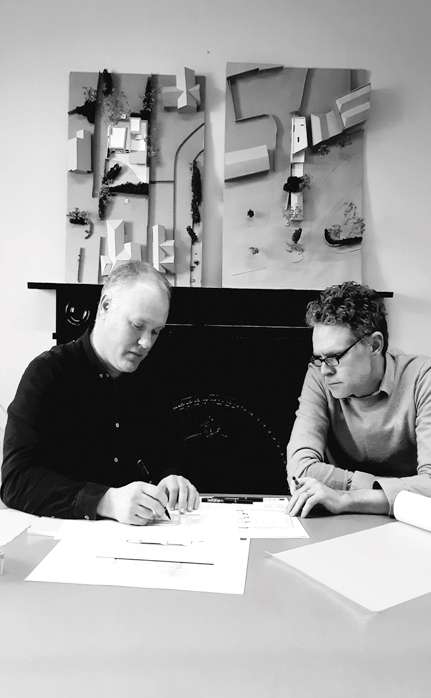
FOCUS ON… BRENNAN FURLONG
In the first of a new series focusing on specific practices around the country, Plan speaks to Gareth Brennan, partner at Brennan Furlong about current work, bcar and whether the current climate is open to creativity…

Can you tell us about the practice?
I set up in 2009 after I was laid off from Henry J. Lyons. It was a risk but actually, I didn’t really have any other choice. I worked from home for about a year, then took an office in Fairview, then an office in Clontarf. In 2013, things started to pick up a little bit and there was a need for another person. I had known Seamus early on in my career, we had first worked together in 2002. In 2013, he was winding down in his role so we began working together. In 2015, we formalised the practice. Back then there were three of us and today, there are 10 people working in the practice. In 2015, we moved into the Chocolate Factory in town. We all loved working in the city but most of our contacts were in the North Dublin suburbs. The traffic was killing us so we moved out to North Strand a year ago.
What kind of projects are you working on at the moment?
Most of our work is still primarily residential. Before setting up Brennan Furlong, the work we both did was primarily commercial – apartments, commercial schemes and student accommodation. At the moment, our work is 80/20 extension and refurbishment versus new builds. It’s the same when it comes to residential versus commercial also. Commercial work started to pick up last year and that’s something we’re excited about. We spent a long time working in commercial, it’s a difference discipline so it’s nice to have a bit of variety.
What was your breakthrough project?
After completing a lot of residential projects, we were looking for one that would help raise the profile of the practice. One particular project in Killester was the first where our design ideas were matched by the client brief. It allowed us to raise the profile of the practice and reach clients who were design focused and had a budget to match. Another project that helped raise the profile of the practice and get our name out there was a house on the Strand Road in Sutton, right opposite the tip of Bull Island.

The clients were great. It had been the client’s mother’s house and he was keen that it wouldn’t be obliterated. We did some research to find out what the house was like originally. In that instance it came down to the client’s confidence in the team that he had assembled. That project has become a reference for other clients.
Do you think there’s more or less creativity in domestic work?
It’s a different type of creativity. The brief tends to be quite specific – you’re designing for a person and it’s very personal to them. At the initial meeting with a potential new client, we listen a lot before we speak. We ask the client to tell us how they live and how they envision using the new house. If they have a current house, we ask what works and what doesn’t. We try to understand as much as possible what they need the house to do for them.
How do you find the current climate in architecture? Are clients willing to take risks?
Whether it’s residential or commercial, the client is entrusting us with a significant budget. It’s a big decision to make and to some degree, a leap of faith. From our perspective it’s about reassuring clients that we are professionals – we have 14 years’ experience in the field and a great team supporting us. That’s helpful to reassure clients that we can deliver the service they’re looking for.

What’s your view on BCAR (Building Control Amendment) regulations (2014/2015)?
It’s very onerous. On the residential front and where possible, clients are opting out. Since that opt out facility came in, we haven’t had a single client opting to go with BCAR and that’s purely down to cost. Clients are obviously looking at the cost and not seeing the benefit. The principal of BCAR is that if you have two new houses beside each other and one house is certified under BCAR and the other under the previous system, the BCAR house should be more valuable but it doesn’t work like that. The market pays no attention to it. The housing market in particular is emotive or illogical, people aren’t making a logical decision between house A and B.
If there’s no added value, is BCAR pointless?
It’s not pointless because something had to be done but I don’t know if it’s necessarily the right or wrong thing. Whether it’s a bit of a carrot or stick thing, it has encouraged tightening up of procedures. When it initially came in, most practices set up an in-house way of complying with BCAR and to a certain degree, we would still use that structure. I think it has encouraged more of a focus on the building regulations themselves. Beforehand we gave an opinion when it came to compliance with regulations and really, how useful is an opinion? I think it has helped create a method of work where best practice is more stringently adhered to so certainly, it has provided a service in that regard.
Do you deal with BCAR compliance in house?
It depends on the scale of the project. On larger commercial stuff, we wouldn’t take it on. The work of an Assigner Certifier is not core to our skill set. It’s supplementary and something we can do on a smaller project, but on a larger project it takes from the time that we could be spending on designing and delivering the best quality building that we can for clients.
What’s it like finding and retaining quality staff at the moment?
It’s challenging in terms of design staff. Any time we’ve posted ads, we’ve received a lot of applications but quite a few of those haven’t really been suited to the role as they’ve been applicants from abroad. The problem with applicants from abroad is they have no knowledge of the Irish planning system or of building regulations. Their portfolios would reflect a local architecture, which isn’t directly applicable to Ireland. They may have great design sensibilities and all the skills in the world in terms of computer programmes but translating that to practical realities and day to day work can be quite challenging. In the last few years we’ve gone from about seven members of staff to 10. In each instance we only had about two or three candidates that we felt having gone through the interview process fitted the bill. We were quite lucky even to find that many.

In the event of another downturn, how prepared are you?
With the last recession there was no choice. As an industry we were battered. Construction and hospitality were the two worst affected sectors, there’s residual trauma still there. There is no sense of “thank God that’s over, happy days now”. I think we’re always aware that it will come again. We know there will be another slowdown but hopefully not to the same extent. We want to position ourselves as best we can to ride it out. When you look at the practices that have been around 30, 40 or 50 years, they have managed to come through several recessions. It’s about developing a brand but also developing a reputation and from our perspective, we have attempted to create an identity for the practice so that when things slow down and the residential market contracts, we’ll have established ourselves to such a degree that we will still be attracting work. Maybe not to the same extent but enough to see ourselves through that patch and come out the other end. We also have the commercial projects which last longer, they have the capacity to pay the bills.
Tell me something that you think works well about the practice
When we set up initially, we talked a lot about what we wanted the practice to be and how we wanted it to evolve. We were fairly aligned in that we wanted it to be a studio that was inclusive and that there was a sense of collective ownership of the work, that each project would be a shared achievement. Even when we set up the studio in town, we designed it so that desks were continuous and everyone was working on the same desk. It was an attempt to create a shared working surface to help foster a sense of collectiveness. When the practice expanded to eight or nine, we were finding that some staff members were overloaded and others were under resourced so we realised we needed to put a structure in place. We decided to split into two teams and that these two teams would be complementary and non-competitive. We have set it up so that Seamus has three people working for him and I have three working for me. Sara is the office manager and Libby the intern floats. The two teams face each other, again it’s a shared surface and there’s a lot of collaboration. So one of the things that works well in the practice is the idea that it’s a studio and an enjoyable place to work. People have really bought into that.
What would you like to improve?
The IT! We’re in the middle of improving our IT which hopefully will have a significant impact. We’re not using BIM yet but a couple of the guys here have trained in it. We know it’s coming down the tracks. We used it for a one-off house in Malahide a couple of years ago and we found it cumbersome. It needs a scale for it to come into its own and for the payback. For a practice like ours, if we were four or five and we only wanted to focus on residential we could manage without it, but if we are looking to do large-scale commercial stuff, it’s necessary. It’s a requirement in the UK for public works so I feel it’s only a matter of time before it’s required here and that will filter through where you have larger scale private clients. BIM will give those clients the ability to operate, maintain and finance the ongoing use of the building; without BIM they won’t be able to do it.
How do you control time spent on projects against fees charged?
We use a percentage fee and base it against what the industry is setting. It works quite well. In terms of keeping track we use Architect Pro, a project management tool that has all sorts of functions but one of them is logging hours. At any stage we can generate a print-out of the amount of hours spent on a project and the amount of fees we anticipate to generate on it.
Do you have any issues with attaining full fees?
When we have initial discussions with clients we try to be as absolutely clear as possible about the fees. We have in-house Excel spreadsheets which track the fees on every project, so we would issue those to the client. Anytime we send an invoice we update the spreadsheet; it’s prepopulated so they can see what happens if they spend €300 instead of €200, they hit the button and it translates into our fees. If we are waiting to sign a contract with a client, we will give them the blank version of that and say, plug in your figures and you’ll see what that translates to in relation to fees. What you don’t want is to be having difficult discussions with clients midway or two thirds of the way through the project when they become unhappy with the fee level. It does happen, it’s inevitable that there are going to be times when a client won’t be overly happy with the way fees are going. We try to ensure that we have given them all the information they need before signing anything.
What do you enjoy most in the day to day practice of architecture? I like the challenge of it. I think it was either John Tuomey or Sheila O’Donnell who said, “you should draw every day.” It’s a good piece of advice. It can be hard to find the time but even if it’s only five minutes that you’re drawing, it’s worth it. That’s why we picked the course in the first place. There are lots of days where you have meetings and phone calls or you’re looking at development plans or regulations, but you have to always try and bring it back to drawing. Today I got two hours work done on a design in the middle of the day. That’s not necessarily the norm, but every day if you can get at least 5 or 10 minutes, that’s what I enjoy most.
____________________________________________________________________________
Denise Maguire Editor of Irish Construction Industry Magazine & Plan Magazine






